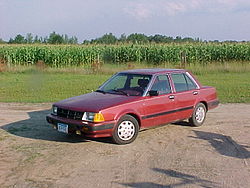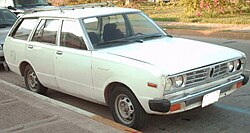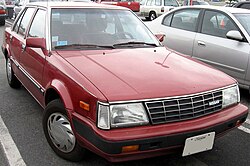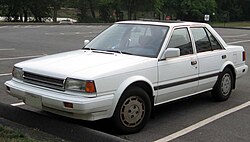Nissan Violet
This article has multiple issues. Please help improve it or discuss these issues on the talk page. (Learn how and when to remove these messages)
No issues specified. Please specify issues, or remove this template. |
This article includes a list of references, related reading, or external links, but its sources remain unclear because it lacks inline citations. (January 2008) |
| Nissan Stanza | |
|---|---|
 | |
| Overview | |
| Manufacturer | Nissan |
| Production | 1977–92 |
| Assembly | Hiratsuka, Japan Oppama, Japan |
| Body and chassis | |
| Class | Compact |
| Chronology | |
| Successor | Nissan Altima |
The Nissan Stanza was a compact car introduced by Nissan in 1977 and was a "badge-engineered" brother to the Nissan Auster and Nissan Violet. All three bore the A10 codename, and were built in Hiratsuka, Japan and Oppama, Japan. A front wheel drive model for the 1982 model year was launched in 1981. Later versions of the car would also be rebadged Nissan Bluebirds.
Violet 710 (1973–77)
Before the Stanza, there was the Violet, which sold overseas as Datsun 140J/160J, or in the USA as Datsun 710. This model was built as 2 door Sedan, 2 door Hardtop Coupe, 4 door Fastback Sedan, 4 door Notchback Sedan, Wagon, and Van. The sporty SSS model has rear independent suspension, others have leaf spring.
It was assembled in Mexico between 1974 and 1978 marketed as Datsun Sedan and Datsun Guayin. It was the first small car sold in Mexico offered with an optional 3 speed automatic gearbox. It is known as the "bolillo" (white bread) because of its rounded design.
The Datsun 710 was probably the most noticed and universally known Datsun of all time. It was offered with IRS suspension and L series engines together with twin S/U carburetion in many parts of the world. It was the choice of road racing enthusiasts as well as off road competition in its 160JSSS version .The 710 series was a spin-off of the Bluebird, conceived as an intermediate model between the Sunny and the Bluebird and marketed by Nissan in various markets as the Violet or the 160J, as well as an 140J version, L14 powerplant. It was a development of the styling already seen in the 610. Markets such as Australia, where the Bluebird was manufactured rather than imported, did not offer the 710 series. In other markets, it was sold alongside the 610.
The Datsun 160J, aka Datsun Violet, and the sportier version, Datsun 160J/Violet SSS had IRS suspension and L 16, 18 and 20B engines and S/U twin carburetors. This later Datsun, the Violet/160JSSS was not offered in the US and Australia, but it was offered in many markets. This Datsun Violet/160JSSS became the biggest winner vehicle Datsun ever had, making inroads in off road competition and road races. This Datsun 160JSSS, with its IRS suspension was Nissans's flag ship in rallye competition and road races in Asia, Europe, Africa and South America. In the US market, this Datsun Violet/160JSSS was tamed into what US markets knew as Datsun 710, a leaf spring Datsun with protruding bumpers, a great Datsun indeed, but a shadow of the mighty Datsun 160JSSS/Violet.The Datsun Violet in Japan was already a Turbo intake Datsun, the only Datsun turboed of those times.
First generation (1977–81)
| First generation | |
|---|---|
 | |
| Overview | |
| Also called | Nissan Auster Nissan Violet Datsun 510 Datsun Stanza Datsun Violet Datsun 140J/160J |
| Production | 1977–81 |
| Body and chassis | |
| Body style | 4-door sedan 4-door station wagon 3 or 5 door hatchback |
| Layout | FR layout |
| Powertrain | |
| Engine | L20B,Z20S,L18,L16 |
| Transmission | 4-speed & 5-speed automatic |
| Dimensions | |
| Wheelbase | Template:Auto in |
| Length | Template:Auto in |
| Width | Template:Auto in |
| Height | Template:Auto in |
The Stanza was first introduced in the 1977 model year as a rebadged Japanese-market Nissan Violet A10. In Australia, it was called the Datsun Stanza, and in the United States the Datsun 510, a name which was intended to recall the previous Datsun 510. It was powered in 1978 models by the 2.0 L I4 L20B and in later years by the 2.0 L, I4 Z20 series of engines.
Five bodystyles were on offer overall, being a 2-door sedan, a 4-door sedan, a 3-door hatchback coupe, a 5-door hatchback (introduced later in the car's production run) and a 5-door wagon. Transmissions offered were a 4 speed manual (all except 3 door hatchback), 5 speed manual (3-door hatchback only), and 3 speed automatic.
Australia
The Stanza was assembled in Australia from 1978 to 1982, in 4-door 1.6L sedan form, primarily to fill a gap between the Sunny and 200B. Trims available were 'GL', 'GX' and sporty 'SSS'.
While popular with buyers, the Australian Stanza was heavily criticized by the motoring journalists of the day (particularly Wheels Magazine), who regarded the car as being 'unadventurous', particularly with regard to its styling and conventional drivetrain.
A little known fact about the Australian Stanza was that in 1979, 120 2-door coupe models were assembled in Australia, apparently due to a mix-up with Nissan Australia's CKD ordering system. These cars were sold primarily in Melbourne, and were not widely advertised by Nissan, because they were not intended to be a regular production model.
New Zealand
New Zealand saw limited CBU imports of the Datsun 160J 3-door hatchback. The car was not widely available, as its place on the New Zealand market was generally filled by the Datsun 120Y and the Datsun Bluebird based 160B.
Motorsports
The Violet 160J was Nissan's most successful car in the World Rally Championship. It won the Safari Rally in Kenya from 1979 to 1982 consecutively, all with Shekhar Mehta behind the wheel. The 1979 and 1980 winners were powered by SOHC engine, the 1981 and 1982 winner are Violet GT with DOHC engine. These Safari records are only matched by the Toyota Celica GT-Four which won the 1992-1995 events. The Violet also won the 1980 New Zealand Rally, and 1981 Ivory Coast Rally.
Second generation (1981–86)
- For the Nissan Stanza Wagon, see Nissan Prairie.
| Second generation | |
|---|---|
 | |
| Overview | |
| Also called | Nissan Auster Nissan Violet |
| Production | 1982–86 |
| Body and chassis | |
| Body style | 4-door sedan 5-door hatchback |
| Layout | FF layout |
| Powertrain | |
| Engine | 1.6, 1.8, and 2.0 liter I4 |
A front-wheel-drive Stanza was introduced in 1981 — the first compact Datsun ever to be of that configuration.
After 1982, Nissan tried to standardize the Stanza name in its export markets. In the US, the T11 Stanza with the same Z20E engine, replaced the 510 for the 1982 model year. In the United States the Nissan Prairie was sold as part of the range, renamed the Stanza Wagon. In 1984, Nissan changed the engine in the Stanza from the Z20E to the 2.0 L, straight-4 CA20E.
3 door hatchback, 4 door sedan, and 5 door liftback models were produced. Japanese and some other export models were called "Stanza FX", and were offered with 1.6 and 1.8 liter engines.
This version was sold in the United Kingdom and Europe as "Stanza"; the range was 1.6 L, 1.6 GL, 1.6 SGL and 1.8 SGL.
In Indonesia, the T11 Stanza 1.6 was the chosen car for the taxi replacement in mid-1980s.
The facelifted Japanese models have flat nose similar to the real Bluebird U11 series.
Third generation (1986–90)
| Third generation | |
|---|---|
 | |
| Overview | |
| Also called | Nissan Auster Nissan Bluebird |
| Production | 1986–90 |
| Body and chassis | |
| Body style | 4-door sedan 5-door hatchback |
| Layout | FF layout |
| Related | Nissan Bluebird Nissan Maxima Nissan Prairie/Stanza Wagon/Multi |
| Powertrain | |
| Engine | 2.0L 94 hp (70 kW) I4 |
| Transmission | 4-speed automatic 5-speed manual |
| Dimensions | |
| Wheelbase | Template:Auto in |
| Length | Template:Auto in |
| Width | Template:Auto in |
| Height | Template:Auto in |
The Stanza line was not seen in most export markets after the 1986 model year. The growth of the Sunny and Pulsar models from below meant there was little room for it. However, it was still seen in the United States, as a sedan with the Nissan Maxima chassis but the same CA20E engine found in the previous Stanza. This led to the car being unusually heavy for its class, and as a result of its smaller engine, underpowered.[1] In part to offset this, some export markets offered turbocharged models badged "Supremo", and a cousin, the Auster XTT.
Nissan renewed the Auster and Stanza lines in 1986 (T12 series), introducing squared-off styling that was at odds with the trend then to rounded shapes such as the Ford Taurus. Japan and the US received this model. Europe received a version of the Nissan Auster as a Bluebird replacement. These were built in Sunderland, in the UK, and badged as the Nissan Bluebird. The station wagon was the only "real" Bluebird in this range, imported from Japan.
Fourth generation (1990–92)
| Fourth generation | |
|---|---|
| 1991 Nissan Stanza | |
| Overview | |
| Also called | Nissan Bluebird Nissan Pintara (Australia) |
| Production | 1990–92 |
| Body and chassis | |
| Body style | 4-door sedan |
| Layout | FF layout |
| Related | Nissan Prairie/Axxess Nissan Altima (1993-97) |
| Powertrain | |
| Engine | 2.0L 112 hp (84 kW) KA24E I4 2.4L 138 hp (103 kW) KA24DE I4 |
| Transmission | 4-speed automatic 5-speed manual |
| Dimensions | |
| Wheelbase | Template:Auto in |
| Length | 1990-91: 4.57 m (179.9 in) 1992: Template:Auto in |
| Width | 1.70 m (66.9 in) |
| Height | 1.37 m (54.1 in) |
For the 1990 model year the American Stanza was replaced by a version of the Nissan Bluebird (U12 series), wearing Stanza badges. The JDM Bluebird has rear license plate between the tail lights, the Stanza's is mounted on the bumper. The fourth generation Stanza was offered in two trim levels: XE and GXE. The sporty SE was added for 1992. This version used the 2.4 L inline-4 Nissan KA24E engine, an upgrade from previous generations in displacement (1974 cc to 2398 cc), power (94 hp to 138 hp), and torque (114 ft·lbf to 148 ft·lbf). This Stanza was discontinued after the 1992 model year and replaced by the American-built Altima, also Bluebird-based. The last American Stanza rolled off the assembly line on March 27, 1992, though its name would live on in the first generation Altima, technically known as the "Nissan Stanza Altima".
In Japan and elsewhere, the Auster and Stanza ranges were effectively replaced by the Nissan Primera for the 1990 model year.
References
- ^ "Maxima History". Retrieved 2006-06-07.
